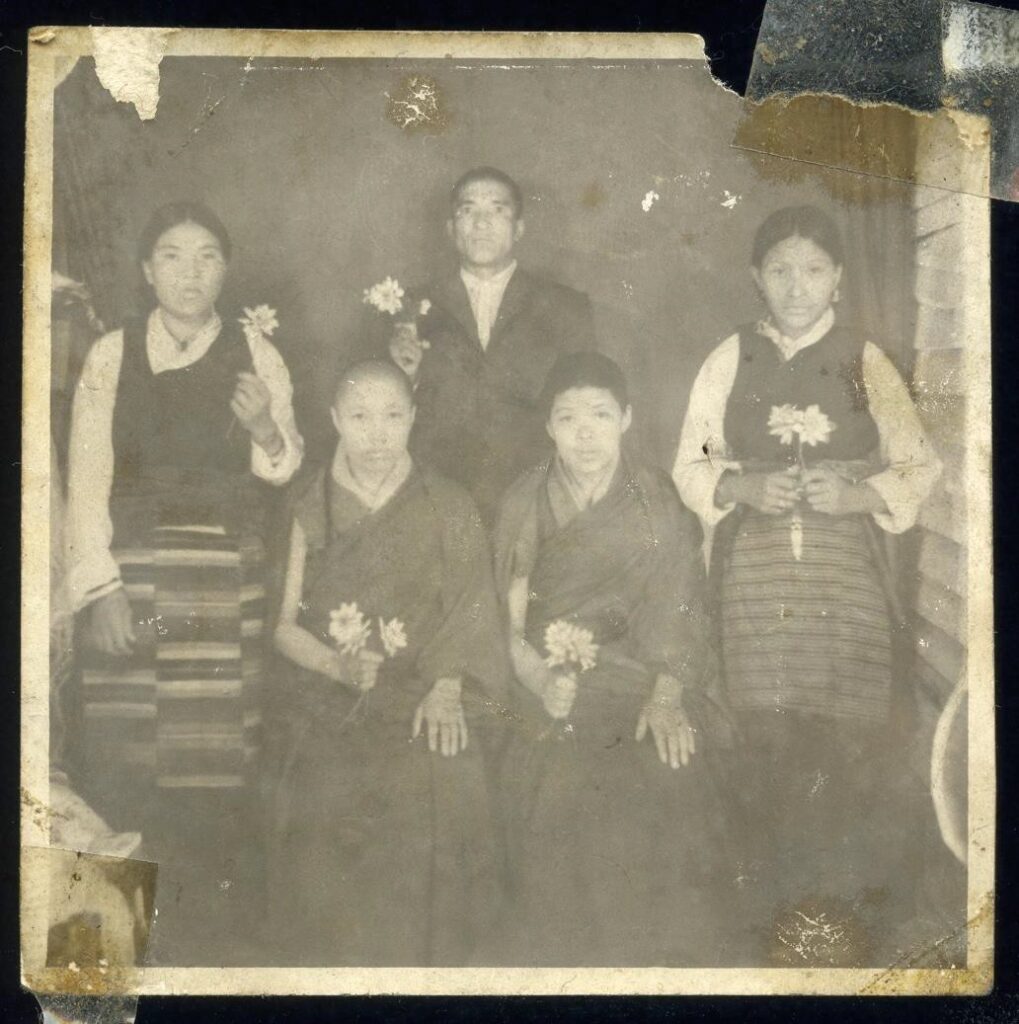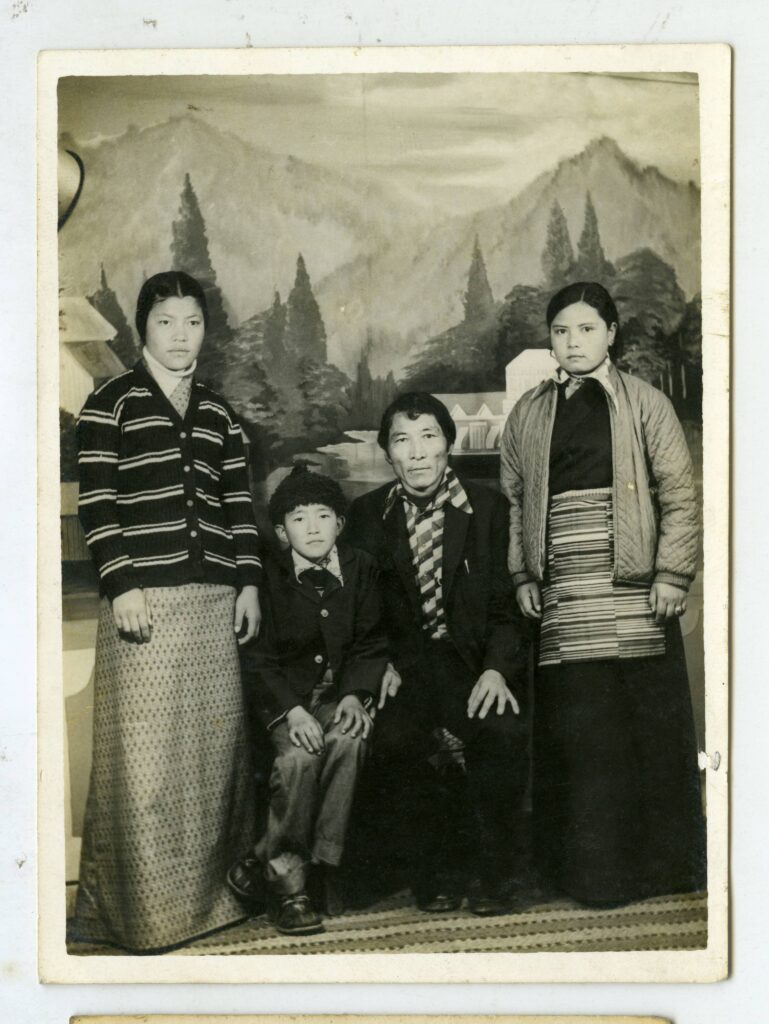ISSN 2768-4261 (Online)

A Journal of Tibetan Literature, Arts and Humanities
The Tibet Memory Project: A Photo Essay
Tsering Topgyal and Tsering Choephel
Thousands of black and white family photographs lie hidden in the households of exile Tibetans scattered around India, Nepal, and Bhutan. They echo individual narratives and the dreams, aspirations, and struggles of the first generation of exile Tibetans. Some are neatly framed and occupy a place within the meaningful order of the household, while others are sympathetically tucked into photo albums on top of shelves and inside cabinets as if to rescue them from the decay of time. What stories do these photos speak of? How do various individuals recall these stories or their own past? In what ways do such old family photos create belongingness and a sense of ‘home’ for Tibetans in exile? Perhaps home is not only found in geographical spaces, but also in the things we ‘keep’. We belong to things as much as they belong to us.
The Tibet Memory Project documents stories of the first generation of Tibetans in exile, through their old personal photographs and fading memories, to build individual narratives into a collective history.
In this short photo-essay, we present three family photographs accompanied by their stories. These photographs were taken in photo studios in the 1960s and 1970s and after excavating abandoned negatives or photographs from these studies, we elicited their stories behind these families using the image. Together these images and narratives seek to counter the monolithic narrative of Tibet and Tibetans. Instead, they seek to highlight the diversity of experiences and lived realities of Tibetans in exile as well as the strands that connect us to ‘home’.
Sonam Jordhen (Tenzigang, Arunachal Pradesh)

“My elder brother went missing during the 1962 Indo-China war. In the chaos of fleeing, he was separated from us in Tawang. We searched for him for a long time but couldn’t find him. Then in 1971, he accidentally found us. When he was separated from us, an officer called Chashoe from the Assam Rifles, who knew my father, found my brother, and took him in. The officer went to our house at the time looking for us, but we had already fled. So, he took care of him. Later he sent my brother to school until 7th or 8th grade. After that, he enrolled him in the Indian army. In 1971, after he had completed his military training, he was passing through Bomdila. By a stroke of luck, he ran into our younger brother. He didn’t recognize our younger brother but did however recognize the clothes he was wearing. Our parents used to always dress us all in similar clothes. And upon seeing the same clothes that he used to wear, he asked the boy his name and the name of his parents. He was so happy. That’s how we were reunited.”
Today, Sonam Jordhen is 70 years old and lives with his wife in Tenzigang Tibetan settlement in Arunachal Pradesh. He was born in Tsona, western Tibet. The family fled into exile, India in 1959 when Sonam Jordhen was only six years old.
Tsering Drolma (Dharamsala, Himachal Pradesh)

“There were seven households in our village Sima in Kyirong. Our family was the largest one. When we were going to renovate our house, we hired a renowned wood maker from Dra village. He arrived with his son Ngodrup. They lived and worked in our house for over a month. During this time, his son and I began a relationship. After they left our village, I received many marriage proposals, one after another. Four families were asking me to marry their sons. But I wasn’t interested. One of the families even came with threats, saying they would force me into marrying their son. When women didn’t accept marriage proposals, it was a common practice to force them into marrying. So, one night I ran away from home and to Nepal, where Ngodrup was at a business trip at the time. From there, we travelled to Darjeeling and then to Kalimpong where job prospects were much better. For the first few months, we worked as porters. In Kalimpong, there were a large number of traders from Tibet and Bhutan. One time, we even carried the luggage of mountaineer Sherpa Tenzin Norgay, all the way to Shasingma (Yatung). There were many Chinese at Shasingma, making roads in the area. After some time, a monk gave us the idea that we should try selling chai (tea) at the bus station. So, we set up a small tea stall at the station and sold tea and snacks. It was quite a good business. Months and a year passed by. I was feeling homesick. On many nights I would cry and cry, dearly missing my mother. So, my husband said, “if you miss your mother so much, then let’s go back home.” So, we left Kalimpong for Nepal. We contacted our family and the Dzong (local administration) in Kyirong. A certain amount of fine was given as punishment, and we were able to return home.”
Today, Tsering Drolma is 92 years old and lives in Dharamsala. Her husband passed away many years ago. Following the Chinese occupation of Tibet, she fled to Nepal in 1960 with her husband and in-laws. After spending two years in a large rehabilitation camp in Trisili, a border area between Kyirong and Nepal, they travelled to India and took up road construction in Shimla. The family worked as roadbuilders in Shimla for six years. When the 14th Dalai Lama’s main temple in exile, the Tsuglagkhang, his residence, and Namgyal monastery was to be built towards the late 1960s, skilled Tibetan craftsmen, like Mola Tsering Drolma’s father-in-law, were called to Dharamsala. Mola Tsering Drolma and the rest of the family followed him and settled down in Dharamsala.
Choephel Tsetan (Darjeeling, West Bengal)

“When I left the army, I was worried about what to do next because I had spent all my life either as a monk, or in the army. I didn’t have any experience of farming or of doing business. My command of Hindi was neither good. Following the suggestion of friends, I started doing seasonal sweater business. In the first year, I naively purchased stylish and colorful clothes of my own liking. Forget profit, the business didn’t even cover the expenses of that year.”
Choephel Tsetan was born in Damchung, central Tibet. He fled into exile in 1959 with fellow monks from Drepung Monastery. Today, he is 86 years old and lives in Darjeeling with his two wives. Together, they have four children. During the seasonal sweater business in the winter months, he runs two shops in two different markets in the state of Gujarat, India. He also owns four shops in Dimapur in Nagaland, which he leases to others.
Tsering Topgyal and Tsering Choephel are independent photographers and storytellers based in New Delhi, India.
© 2021 Yeshe | A Journal of Tibetan Literature, Arts and Humanities